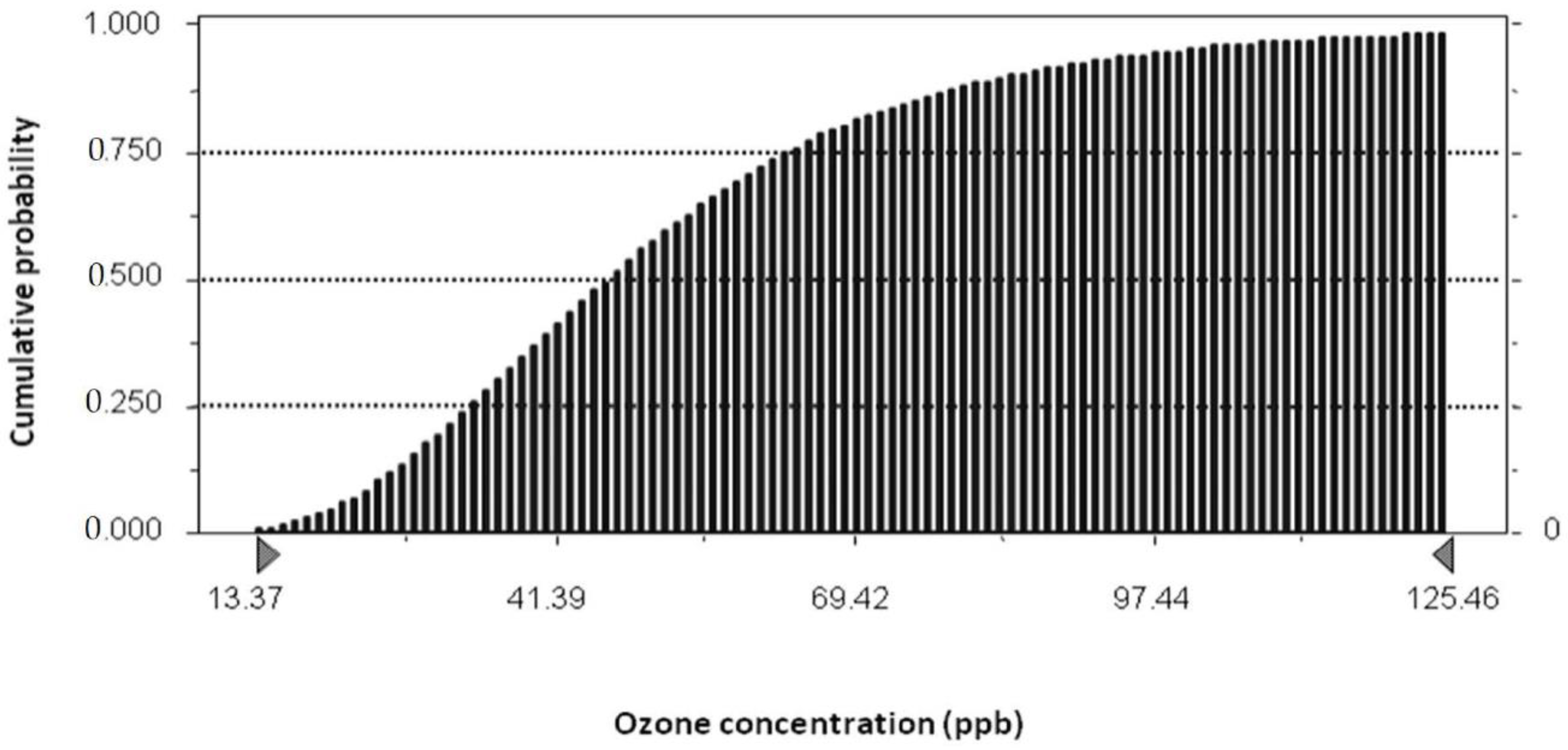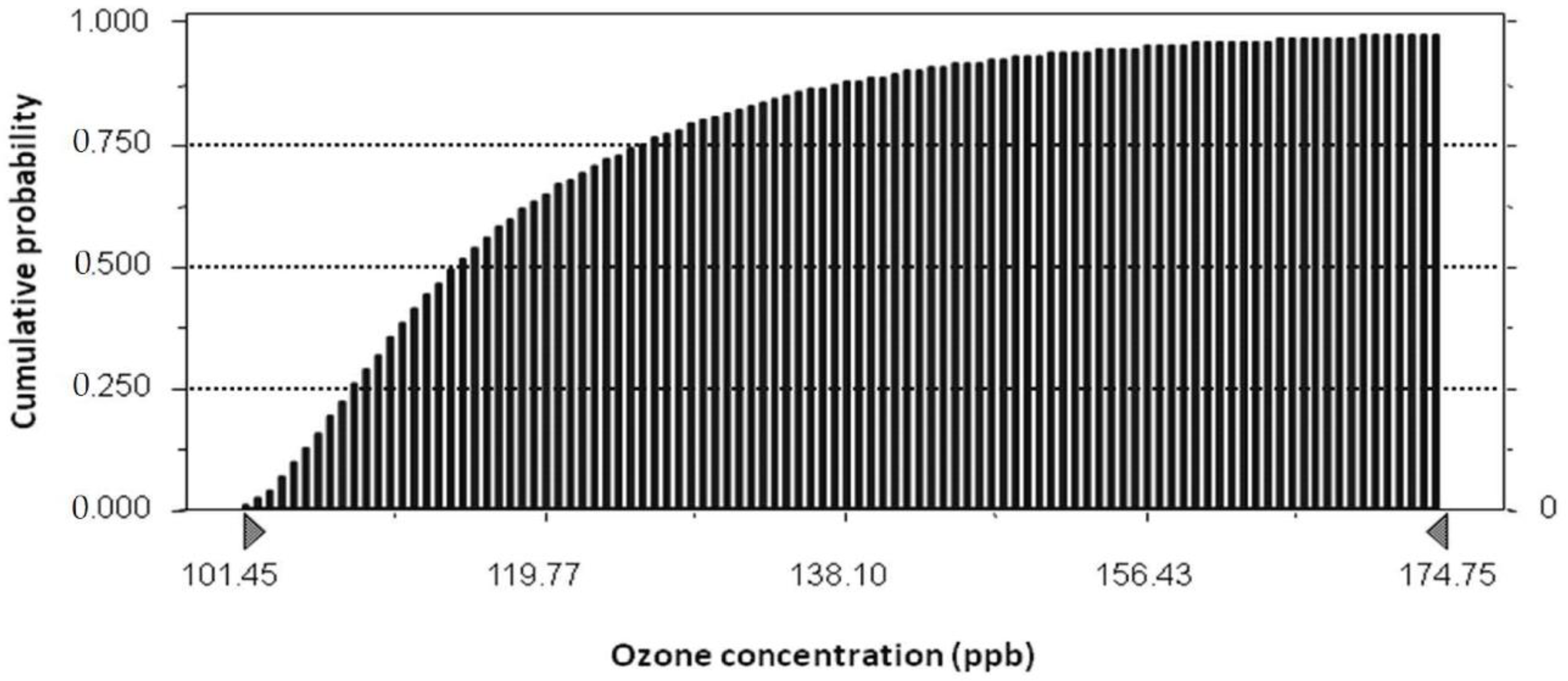Effects of an Ozone-Based Domestic Clothes Washer/Dryer on Indoor Air Quality: A Probabilistic Risk Assessment Study
Abstract
:Featured Application
Abstract
1. Introduction
2. Materials and Methods
2.1. Experimental Measurements
2.2. Risk Assessment
3. Results
3.1. Toxicological Evaluation
3.2. Exposure Assessment
3.3. Risk Characterization
4. Discussion
5. Conclusions
Author Contributions
Funding
Institutional Review Board Statement
Informed Consent Statement
Data Availability Statement
Acknowledgments
Conflicts of Interest
References
- Accelerating Energy Efficiency: What Governments Can Do Now to Deliver Energy Savings—Analysis. Available online: https://www.iea.org/commentaries/accelerating-energy-efficiency-what-governments-can-do-now-to-deliver-energy-savings (accessed on 3 October 2022).
- Emissions of Ozone Precursors—European Environment Agency. Available online: https://www.eea.europa.eu/data-and-maps/indicators/emissions-of-ozone-precursors-version-2/assessment-4 (accessed on 30 September 2022).
- Zhang, J.; Wei, Y.; Fang, Z. Ozone Pollution: A Major Health Hazard Worldwide. Front. Immunol. 2019, 10, 2518. [Google Scholar] [CrossRef] [PubMed] [Green Version]
- Health Canada. Residential Indoor Air Quality Guideline: Ozone. Available online: https://www.canada.ca/en/health-canada/services/publications/healthy-living/residential-indoor-air-quality-guideline-ozone.html (accessed on 30 September 2022).
- Soares, A.R.; Silva, C. Review of Ground-Level Ozone Impact in Respiratory Health Deterioration for the Past Two Decades. Atmosphere 2022, 13, 434. [Google Scholar] [CrossRef]
- Swanson, T.J.; Jamal, Z.; Chapman, J. Ozone Toxicity. In StatPearls; StatPearls Publishing: Treasure Island, FL, USA, 2022. [Google Scholar]
- Krishna, M.T.; Blomberg, A.; Biscione, G.L.; Kelly, F.; Sandstrom, T.; Frew, A.; Holgate, S. Short-Term Ozone Exposure Upregulates P-Selectin in Normal Human Airways. Am. J. Respir. Crit. Care Med. 1997, 155, 1798–1803. [Google Scholar] [CrossRef] [PubMed]
- Liu, L.-J.S.; Koutrakis, P.; Leech, J.; Broder, I. Assessment of Ozone Exposures in the Greater Metropolitan Toronto Area. J. Air Waste Manag. Assoc. 1995, 45, 223–234. [Google Scholar] [CrossRef] [PubMed] [Green Version]
- McDonnell, W.F.; Horstman, D.H.; Hazucha, M.J.; Seal, E.; Haak, E.D.; Salaam, S.A.; House, D.E. Pulmonary Effects of Ozone Exposure during Exercise: Dose-Response Characteristics. J. Appl. Physiol. Respir. Environ. Exerc. Physiol. 1983, 54, 1345–1352. [Google Scholar] [CrossRef] [PubMed]
- Seal, E.; McDonnell, W.F.; House, D.E. Effects of Age, Socioeconomic Status, and Menstrual Cycle on Pulmonary Response to Ozone. Arch. Environ. Health Int. J. 1996, 51, 132–137. [Google Scholar] [CrossRef]
- USEPA. Ozone Population Exposure Analysis for Selected Urban Areas; U.S. Environmental Protection Agency: Research Triangle Park, NC, USA, 2005.
- International Electrotechnical Commission. Particular Requirements for Air-Cleaning Appliances; INTERNATIONAL STANDARD IEC 60335-2-65; International Electrotechnical Commission: Research Triangle Park, NC, USA, 2002. [Google Scholar]
- Morrison, G.; Shaughnessy, R.; Shu, S. Setting Maximum Emission Rates from Ozone Emitting Consumer Appliances in the United States and Canada. Atmos. Environ. 2011, 45, 2009–2016. [Google Scholar] [CrossRef]
- Schwartz, J. Air Pollution and Children’s Health. Pediatrics 2004, 113, 1037–1043. [Google Scholar] [CrossRef] [PubMed]
- World Health Organization. Children’s Health and the Environment: A Global Perspective: A Resource Manual for the Health Sector/J. Pronczuk de Garbino, Editor-in-Chief. 2005. Available online: https://apps.who.int/iris/handle/10665/43162 (accessed on 3 November 2022).
- Dimakopoulou, K.; Douros, J.; Samoli, E.; Karakatsani, A.; Rodopoulou, S.; Papakosta, D.; Grivas, G.; Tsilingiridis, G.; Mudway, I.; Moussiopoulos, N.; et al. Long-Term Exposure to Ozone and Children’s Respiratory Health: Results from the RESPOZE Study. Environ. Res. 2020, 182, 109002. [Google Scholar] [CrossRef] [PubMed]
- Adams, W.C. Comparison of Chamber and Face Mask 6.6-Hour Exposure to 0.08 Ppm Ozone via Square-Wave and Triangular Profiles on Pulmonary Responses. Inhal. Toxicol. 2003, 15, 265–281. [Google Scholar] [CrossRef] [PubMed]
- Adams, W.C. Relation of Pulmonary Responses Induced by 6.6-h Exposures to 0.08 Ppm Ozone and 2-h Exposures to 0.30 Ppm Ozone via Chamber and Face-Mask Inhalation. Inhal. Toxicol. 2003, 15, 745–759. [Google Scholar] [CrossRef] [PubMed]
- Union Pean. Directive 2008/50/EC of the European Parliament and of the Council of 21 May 2008 on Ambient Air Quality and Cleaner Air for Europe. Off. J. Eur. Union 2008, 152, 1–44. [Google Scholar]
- World Health Organization. WHO Global Air Quality Guidelines: Particulate Matter (PM2.5 and PM10), Ozone, Nitrogen Dioxide, Sulfur Dioxide and Carbon Monoxide; World Health Organization: Geneva, Switzerland, 2021; ISBN 9789240034228. [Google Scholar]
- Nazaroff, W.W.; Weschler, C.J. Indoor Ozone: Concentrations and Influencing Factors. Indoor Air 2022, 32, e12942. [Google Scholar] [CrossRef] [PubMed]
- Sousa, S.I.V.; Alvim-Ferraz, M.C.M.; Martins, F.G. Health Effects of Ozone Focusing on Childhood Asthma: What Is Now Known—A Review from an Epidemiological Point of View. Chemosphere 2013, 90, 2051–2058. [Google Scholar] [CrossRef] [PubMed]
- Toxicology of Drugs and Chemicals by Deichmann, William B. & Gerarde, Horace W.: (1969) Fourth Edition|Xochi’s Bookstore & Gallery. Available online: https://www.abebooks.com/9780122088582/Toxicology-Drugs-Chemicals-Deichmann-William-0122088581/plp (accessed on 30 September 2022).
- Giel, C.; Kleinfeld, M.; Tabershaw, I.R. Health Hazards Associated with Inert-Gas-Shielded Metal Arc Welding. AMA Arch. Ind Health 1957, 15, 27–31. [Google Scholar] [PubMed]
- US EPA. Ozone (O3) Air Quality Standards. Available online: https://www.epa.gov/naaqs/ozone-o3-air-quality-standards (accessed on 30 September 2022).
- Renwick, A.G.; Lazarus, N.R. Human Variability and Noncancer Risk Assessment- An Analysis of the Default Uncertainty Factor. Regul. Toxicol. Pharm. 1998, 27, 3–20. [Google Scholar] [CrossRef] [PubMed]
- Weschler, C.J. Ozone in Indoor Environments: Concentration and Chemistry. Indoor Air 2000, 10, 269–288. [Google Scholar] [CrossRef] [PubMed] [Green Version]
- Baba, S.; Satoh, S.; Yamabe, C. Development of Measurement Equipment of Half Life of Ozone. Vacuum 2002, 65, 489–495. [Google Scholar] [CrossRef]
- A Call to Action on Efficient and Smart Appliances—Analysis. Available online: https://www.iea.org/articles/a-call-to-action-on-efficient-and-smart-appliances (accessed on 3 November 2022).




| S (mg/h) | P (Unitless) | V (m3) | Kd (h−1) a | λ (h−1) a | C0(µg/m3) a |
|---|---|---|---|---|---|
| 5 | 1 | 15 | 3.75 ± 2.10 | 0.51 ± 0.68 | 42.5 ± 41.8 |
| Toxicological Parameters/Health-Based Guidance Values/Air Quality Standards | Organizations | Reference | |
|---|---|---|---|
| Outdoor | |||
| Short exposure | Long exposure | ||
| LOAEL a = 120 ppb RfC c = 4 ppb | NOAEL b = 40 ppb LOAEL b = 80 ppb RfC c = 4 ppb | Health Canada | [4] |
| Information threshold = 90 ppb Alert threshold= 120 ppb | Target valued = 60 ppb | European Union | [19] |
| Air Quality Guideline = (AQG) d = 30 ppb e | World Health Organization | [20] | |
| Indoor | |||
| Maximum Exposure Limit f = 20 ppb | Health Canada | [4] | |
| Acute Exposure a | Chronic Exposure b | Reference |
|---|---|---|
| TLV-IDLH = 5 ppm | TLV-TWA = 0.1 ppm light work TLV-TWA = 0.08 ppm moderate work TLV-TWA = 0.05 ppm heavy work | [23] |
Publisher’s Note: MDPI stays neutral with regard to jurisdictional claims in published maps and institutional affiliations. |
© 2022 by the authors. Licensee MDPI, Basel, Switzerland. This article is an open access article distributed under the terms and conditions of the Creative Commons Attribution (CC BY) license (https://creativecommons.org/licenses/by/4.0/).
Share and Cite
Davoli, E.; Paiano, V.; Fattore, E. Effects of an Ozone-Based Domestic Clothes Washer/Dryer on Indoor Air Quality: A Probabilistic Risk Assessment Study. Appl. Sci. 2022, 12, 11466. https://doi.org/10.3390/app122211466
Davoli E, Paiano V, Fattore E. Effects of an Ozone-Based Domestic Clothes Washer/Dryer on Indoor Air Quality: A Probabilistic Risk Assessment Study. Applied Sciences. 2022; 12(22):11466. https://doi.org/10.3390/app122211466
Chicago/Turabian StyleDavoli, Enrico, Viviana Paiano, and Elena Fattore. 2022. "Effects of an Ozone-Based Domestic Clothes Washer/Dryer on Indoor Air Quality: A Probabilistic Risk Assessment Study" Applied Sciences 12, no. 22: 11466. https://doi.org/10.3390/app122211466







